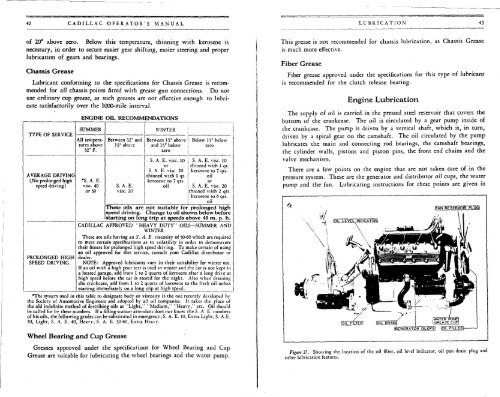1928 Cadillac - GM Heritage Center
1928 Cadillac - GM Heritage Center
1928 Cadillac - GM Heritage Center
You also want an ePaper? Increase the reach of your titles
YUMPU automatically turns print PDFs into web optimized ePapers that Google loves.
42 CADILLAC OPERATOR'S MANUAL<br />
LUBRICATION 43<br />
of 20° above zero. Below this temperature, thinning with kerosene is<br />
necessary, in order to secure easier gear shifting, easier steering and proper<br />
lubrication of gears and bearings.<br />
Chassis Grease<br />
Lubricant conforming to the specifications for Chassis Grease is recommended<br />
for all chassis points fitted with grease gun connections. Do not<br />
use ordinary cup grease, as such greases are not effective enough to lubricate<br />
satisfactorily over the 1000-mile interval.<br />
TYPE OF SERVICE<br />
AVERAGE DRIVING<br />
CNo prolonged high<br />
speed driving")<br />
PROLONGED HIGH<br />
SPEED DRIVING.<br />
ENGINE OIL RECOMMENDATIONS<br />
SUMMER<br />
All temperatures<br />
above<br />
32° F.<br />
*S. A. E.<br />
vise. 40<br />
or 50<br />
Between 32° and<br />
15° above<br />
S. A. E.<br />
vise. 20<br />
WINTER<br />
Between 15° above<br />
and 15° below<br />
zero<br />
S. A. E. vise. 10<br />
or<br />
S. A. E. vise. 20<br />
thinned with I qt.<br />
kerosene to 7 qts.<br />
oil<br />
i<br />
Below 15 = below<br />
zero<br />
S. A. E. vise. 10<br />
thinned with 1 qt.<br />
kerosene to 7 qts.<br />
oil<br />
or<br />
S. A. E. vise. 20<br />
thinned with 2 qts.<br />
kerosene to 6 qts.<br />
oil<br />
These oils are not suitable for prolonged high<br />
speed driving. Change to oil shown below before<br />
starting on long trip at speeds above 45 m. p. h.<br />
CADILLAC APPROVED "HEAVY DUTY" OILS—SUMMER AND<br />
WINTER<br />
These are oils having an S. A. E. viscosity of 50-60 which are required<br />
to meet certain specifications as to volatility in order to demonstrate<br />
their fitness for prolonged high speed driving. To make certain of using<br />
an oil approved for this service, consult your <strong>Cadillac</strong> distributor or<br />
dealer.<br />
NOTE: Approved lubricants vary in their suitability for winter use.<br />
If an oil with a high pour test is used in winter and the car is not kept in<br />
a heated garage, add from 1 to 2 quarts of kerosene after a long drive at<br />
high speed before the car is stored for the night. Also when draining<br />
the crankcase, add from 1 to 2 quarts of kerosene to the fresh oil unless<br />
starting immediately on a long trip at high speed.<br />
The system used in this table to designate body or viscosity is the one recently developed by<br />
the Society of Automotive Engineers and adopted by all oil companies. It takes the place of<br />
the old indefinite method of describing oils as "Light," "Medium," "Heavy," etc. Oil should<br />
be called for by these numbers. If a filling station attendant does not know the S. A. E. numbers<br />
of his oils, the following grades can be substituted in emergency; S. A. E. 10, Extra Light; S. A.E.<br />
20, Light; S. A. E. 40, Heavy; S. A. E. 50-60, Extra Heavy".<br />
Wheel Bearing and Cup Grease<br />
Greases approved under the specifications for Wheel Bearing and Cup<br />
Grease are suitable for lubricating the wheel bearings and the water pump.<br />
This grease is not recommended for chassis lubrication, as Chassis Grease<br />
is much more effective.<br />
Fiber Grease<br />
Fiber grease approved under the specifications for this type of lubricant<br />
is recommended for the clutch release bearing.<br />
Engine Lubrication<br />
The supply of oil is carried in the pressed steel reservoir that covers the<br />
bottom of the crankcase. The oil is circulated by a gear pump inside of<br />
the crankcase. The pump is driven by a vertical shaft, which is, in turn,<br />
driven by a spiral gear on the camshaft. The oil circulated by the pump<br />
lubricates the main and connecting rod bearings, the camshaft bearings,<br />
the cylinder walls, pistons and piston pins, the front end chains and the<br />
valve mechanism.<br />
There are a few points on the engine that are not taken care of in the<br />
pressure system. These are the generator and distributor oil cups, the water<br />
pump and the fan. Lubricating instructions for these points are given in<br />
Figure 27. Showing the location of the oil filter, oil level indicator, oil pan drain plug and<br />
other lubrication features.
















